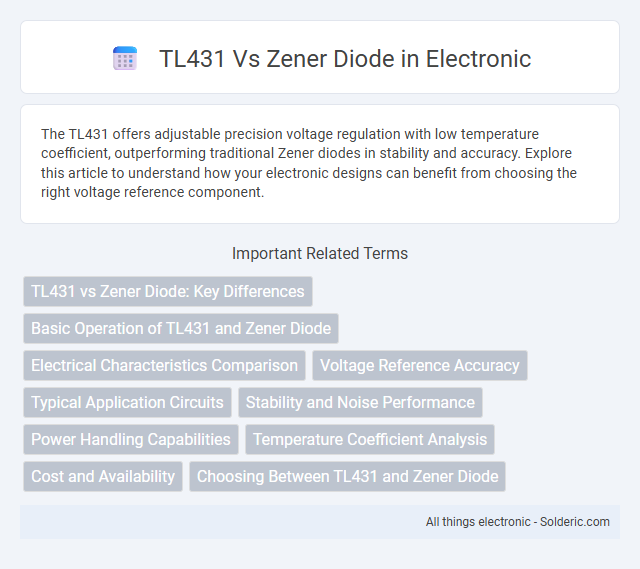The TL431 offers adjustable precision voltage regulation with low temperature coefficient, outperforming traditional Zener diodes in stability and accuracy. Explore this article to understand how your electronic designs can benefit from choosing the right voltage reference component.
Comparison Table
| Feature | TL431 | Zener Diode |
|---|---|---|
| Type | Adjustable Shunt Regulator | Fixed Voltage Reference Diode |
| Voltage Range | 2.5V to 36V Adjustable | Typically 2.4V to 200V Fixed |
| Accuracy | +-1% Typical | +-5% to +-10% |
| Temperature Stability | Good, Low Drift | Moderate, Higher Drift |
| Reference Voltage | Internal Bandgap Reference (2.495V) | Breakdown Voltage |
| Adjustability | Yes, via External Resistors | No, Fixed Value |
| Application | Precision Voltage Regulation, Adjustable Voltage Reference | Voltage Clamping, Simple Voltage Regulation |
| Package Types | SOT-23, TO-92, SOIC | DO-35, SOD-123, SOT-23 |
| Current Rating | Up to 100mA | Varies, Typically up to 1A |
| Cost | Moderate | Low |
TL431 vs Zener Diode: Key Differences
The TL431 is a programmable shunt voltage regulator that offers precise voltage reference adjustment typically ranging from 2.5V to 36V, while a Zener diode provides a fixed voltage reference with standard voltage levels commonly available between 2.4V and 200V. Unlike Zener diodes that have relatively higher temperature coefficients and lower accuracy, the TL431 features better temperature stability and tighter tolerance, making it ideal for precision voltage regulation in power supplies and voltage reference circuits. The TL431 operates with an internal op-amp and feedback network, enabling dynamic voltage regulation, whereas Zener diodes rely solely on avalanche breakdown, resulting in simpler but less flexible applications.
Basic Operation of TL431 and Zener Diode
The TL431 functions as an adjustable precision shunt regulator with a stable reference voltage typically set at 2.5V, enabling precise voltage regulation through an internal op-amp and a reference voltage source. In contrast, a Zener diode operates by breaking down at its specified Zener voltage, providing a fixed voltage reference used mainly for voltage stabilization in circuits. Both devices regulate voltage, but the TL431 offers higher accuracy and adjustability compared to the fixed voltage level of a Zener diode.
Electrical Characteristics Comparison
The TL431 offers precise voltage regulation with a programmable reference voltage typically ranging from 2.5 V to 36 V, enabling tighter control compared to fixed-voltage Zener diodes, which usually have voltage tolerances around +-5%. The TL431 exhibits lower dynamic impedance, often below 0.5 O at its operating current, providing better stability and less noise, whereas Zener diodes generally have higher dynamic impedance, leading to larger voltage variations under load. Additionally, the TL431's adjustable output and temperature stability outperform most Zener diodes, making it more suitable for accurate voltage reference applications in power supplies and precision circuits.
Voltage Reference Accuracy
The TL431 offers superior voltage reference accuracy, typically within +-1% compared to the generally wider tolerance range of Zener diodes, which can vary from +-5% to +-20%. Its adjustable output voltage allows precise regulation in circuits where exact voltage references are crucial, unlike the fixed voltage characteristic of Zener diodes. Your choice of the TL431 can enhance stability and accuracy in sensitive electronic applications requiring consistent voltage performance.
Typical Application Circuits
The TL431 is commonly used in precision voltage regulation circuits, such as adjustable power supplies and feedback loops in switching regulators, where tight voltage control is required. Zener diodes are typically employed in voltage clamping, reference voltage, and simple shunt regulator circuits to provide fixed voltage levels with moderate accuracy. While the TL431 offers better stability and adjustable output compared to the Zener diode, the latter's simplicity makes it suitable for low-cost, less precise applications.
Stability and Noise Performance
The TL431 offers superior voltage stability and noise performance compared to Zener diodes due to its internal error amplifier and precise voltage reference circuitry, resulting in tighter regulation and lower output noise. Zener diodes exhibit higher voltage drift and increased noise under varying temperature and current conditions, making them less ideal for precision applications. The TL431's adaptability in feedback control circuits enhances overall stability, especially in low-noise power supply designs.
Power Handling Capabilities
The TL431 offers superior power handling capabilities compared to standard Zener diodes, with a typical power dissipation rating of up to 1 watt, allowing more efficient voltage regulation in demanding applications. Zener diodes generally have lower power ratings, often around 0.5 watts or less, which limits their use in high-power scenarios without additional cooling measures. The TL431's internal structure and adjustable reference voltage also contribute to enhanced thermal stability and reliability under higher load conditions.
Temperature Coefficient Analysis
The TL431 features a low and stable temperature coefficient, typically around +1.4 mV/degC, making it ideal for precision voltage reference applications. In contrast, Zener diodes exhibit higher and more variable temperature coefficients, often negative or positive depending on the breakdown voltage, which can cause voltage drift in your circuits. Selecting the TL431 over Zener diodes improves temperature stability and overall performance in voltage regulation tasks.
Cost and Availability
TL431 shunt voltage regulators typically cost more than standard Zener diodes due to their precise voltage regulation and adjustable output features. Zener diodes are widely available, inexpensive, and commonly used for basic voltage clamping, making them a cost-effective choice for simple applications. Your choice depends on balancing budget constraints and the need for voltage accuracy and stability in your circuit design.
Choosing Between TL431 and Zener Diode
Choosing between TL431 and Zener diode depends on precision, adjustability, and application requirements. TL431 offers a programmable voltage reference with tighter tolerance and lower temperature drift compared to standard Zener diodes, making it ideal for precision voltage regulation and feedback circuits. Zener diodes are preferred for simple voltage clamping and less critical voltage regulation tasks due to their lower cost and simpler implementation.
TL431 vs Zener Diode Infographic

 solderic.com
solderic.com